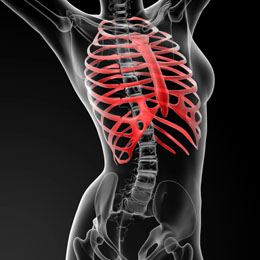Pain due to a bruised rib may also be accompanied by painful or labored breathing. Scroll down to know about the various treatment options that can be used for bruised ribs.

The human ribcage, also known as the 'thoracic cage', guards vital organs such as the heart and the lungs by forming a skeletal cage around the organs. It consists of a set of 24 rib bones, each attached to a part of the spine, called the thoracic vertebrae. Ribs may get bruised if one receives a strong blow to the chest. The injury can vary from a minor bruise, in which the rib moves out of line and damages the adjoining muscles and tissues, to more severe cases such as broken and separated ribs. Athletes, football players, ice-hockey players, etc., are more susceptible to such injuries. Driving accidents can also lead to bruised ribs.
Severe injuries that cause rib separation, or a broken rib, may cause muscle spasms, thereby making respiration a painful process. Any broken rib may have sharp edges that protrudes and causes further damage by puncturing the lungs. You may feel pain while you breathe, laugh or even sneeze. Here are some things that can be done in such cases...
Visit a Doctor
The first and foremost thing that has to be done regarding a bruised rib is to go to a doctor and get a chest X-ray or a CT scan to find out the accurate condition of the ribs. It is very important to know the actual condition of the ribs before you go in for any sort of treatment. Shortness of breath caused by the inability of the lung to expand fully may also cause a lung infection or pneumonia. The most usual cure for this condition is to take painkillers and anti-inflammatory drugs as suggested by the doctor. Depending on the severity of the injury, sometimes, anti-inflammatory medications work well in relieving pain. One of them is Ibuprofen. According to the diagnosis, even stronger medication may be needed to be taken to address the condition. In some cases, broken or severed ribs may even require surgery.
Apply Ice
The basic treatment is to apply ice to the damaged area at regular intervals, for at least 48 hours, or until the pain subsides. Applying ice helps to relieve inflammation.
Use A Rib Pad
Minor bruises can be cured by using a rib pad/belt. The pad creates a compact wrapping around the ribcage, thereby minimizing movement. A patient is usually advised to take complete rest while wearing the belt, so that the separated or broken rib is allowed time to heal. However, consult a physician before wearing a rib belt.
Heat Treatment
This can only be done after a few days when the swelling or inflammation has subsided. Heat treatment by an electric pad, a warm compress, or even a warm bath will help in relieving pain.
Breathing Exercises
At such times, it is important that the lungs work well, and for this, breathing exercises come in handy. Taking deep breaths is a very good idea. Hold the breath for a few seconds and release it slowly. Repetitions of 10 times every couple of hours would be quite beneficial.
Bed Rest
Unlike a fractured hand or arm, the rib cannot be immobilized, which in effect, results in the treatment process becoming lengthy, as the ribs need to be allowed time to heal by themselves. The treatment for bruised ribs is mostly accompanied by bed rest. The patient is also required to abstain from any activity that may aggravate the pain. Avoid strenuous activities and exercises, and also do not try to lift heavy objects.
Pain in the thoracic area should never be ignored, and proper care should be taken in such cases. A proper diagnosis is very important in order to prevent potential damage to the nearby organs. Rib belts and rib pads should also be used only after consultation with a doctor. Exercises may need to be performed post-injury to heal the muscles and tissues associated with the injured rib(s), only after being advised by a doctor.
Disclaimer:
This Buzzle article is for informative purposes only, and should not be used as a replacement for professional medical advice.


 The human ribcage, also known as the 'thoracic cage', guards vital organs such as the heart and the lungs by forming a skeletal cage around the organs. It consists of a set of 24 rib bones, each attached to a part of the spine, called the thoracic vertebrae. Ribs may get bruised if one receives a strong blow to the chest. The injury can vary from a minor bruise, in which the rib moves out of line and damages the adjoining muscles and tissues, to more severe cases such as broken and separated ribs. Athletes, football players, ice-hockey players, etc., are more susceptible to such injuries. Driving accidents can also lead to bruised ribs.
The human ribcage, also known as the 'thoracic cage', guards vital organs such as the heart and the lungs by forming a skeletal cage around the organs. It consists of a set of 24 rib bones, each attached to a part of the spine, called the thoracic vertebrae. Ribs may get bruised if one receives a strong blow to the chest. The injury can vary from a minor bruise, in which the rib moves out of line and damages the adjoining muscles and tissues, to more severe cases such as broken and separated ribs. Athletes, football players, ice-hockey players, etc., are more susceptible to such injuries. Driving accidents can also lead to bruised ribs.